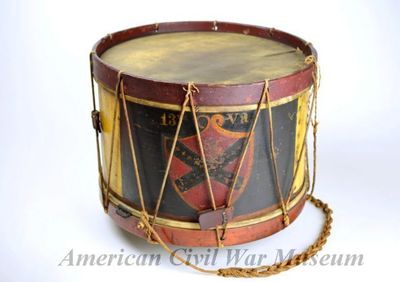James W. wright
House and Sign Painter
A wonderful article was written by Howard Michael Madaus titled, "WRIGHT & BELL/ JAMES W. WRIGHT: DRUM MAKERS OF THE CONFEDERACY." The article is a treasure trove of information about a firm that produced drums in Richmond during the early years of the war. Much of the information discussed here was gathered from that article.
James Wright was born on July 23, 1811 in Virginia. Wright first appears in the 1850 Richmond Census as a painter. In the 1860 Richmond Directory, James Wright is listed as a house and sign painter. Two of his sons are listed as painter apprentices in the 1860 census, obviously learning the trade from their father.
Most drum makers, that I have studied, usually come from a wood working trade, such as cabinet maker, cooper, carpenter, and turner, among others. Dealers of military goods sold pretty much everything and often bought items they didn't make to sell on a retail basis. Since
Wright doesn't appear to be a dealer, and his trade didn't necessarily involve woodworking skills, or tools, his partner, "Bell," must have had that knowledge.
In the 1860 Richmond Directory, there are a few "Bells" that could potentially be part of the firm. The first is "A. M. C. Bell" listed in the "Carpenters and Builders" section of the directory, and the other is Thomas Bell, part of the firm Bell and Hughes which are listed under "Planing Mills." At this time, I am unsure which "Bell" was the partner, and further investigation is needed. According to Madaus's article, he contends that it was Thomas Bell, but I am unsure of how he came to that conclusion.
Between 1861 and 1862, Wright and Bell delivered approximately one-hundred and eleven drums to the Confederate government. Some orders included sticks and "belt," which I assume would be a sling, and later orders were for only "drums." Along with the construction of drums, Wright also seems to have made repairs and supply other components such as drum heads. Wright's final order occurred in April of 1863 for the 5th Louisiana Infantry. James Wright died on November 23, 1863.
"DIED,
At his late residence on Clay street, on the 21st instant, of pleurisy and pneumonia, Mr. JAMES WRIGHT, in the fifty-third year of his age. He was sick only one short week when God called him to Himself. Mr. Wright leaves a wife and six children to mourn his loss, also a large circle of friends and acquaintances, who were deeply attached to him. He had long been a member of the Presbyterian Church and was, at the time of his death, connected with the United [Presbyterian] Church of this city. Mr. W. was for years a [member of] the First Presbyterian Church, Portsmouth."
Richmond Examiner, The (Richmond, VA) - Tuesday, December 1, 1863


16 1/2" diameter by 12 1/2" tall.
One of the most unique Confederate made drums, includes a yellow painted shell, a field of blue with a St. Andrews Cross shield and "12 VA" painted above. The red painted counter hoops are secured with iron nails, and the brass tack design is similar to those seen on norther made drums.

Label reads, "Confederate Drum Manufactury, Richmond, Virginia. Kettle and bass drums of all sizes and of the best materials made to order. Drums repaired and heads furnished at short notice. Kettle drums, complete, from $12 to $-- (illegible). Bass " " " $18 to $-- (illegible). Cash must invariably accompany all orders from a distance to ensure there (sic) being filled. Transportation and all ris

A brass thumb screw snare strainer, common for the period, is attached to the bottom counter hoop. Six strands of gut lay across the bottom snare head attached to a leather butt plate.

16" Diameter by 13 3/4" Tall
1 1/2" Tall Hoops
Another Wright manufactured drum located at the Annmary Brown Memorial. Pictures and information courtesy of Will Chappelle.
This rare eagle motif is similar in design to those of its northern produced counterparts. The eagle clutches a bundle of arrows in one talon, while holding the "stars and bars" in the other. A ribbon flowing from the beak reads

A simple tack design of two vertical rows of tacks and a singular circle surrounding the vent, which is decorated with a bone vent insert.

The shell of the drum appears to be a tight grained wood, possibly ash, but I am not positive.
This website uses cookies.
We use cookies to analyze website traffic and optimize your website experience. By accepting our use of cookies, your data will be aggregated with all other user data.